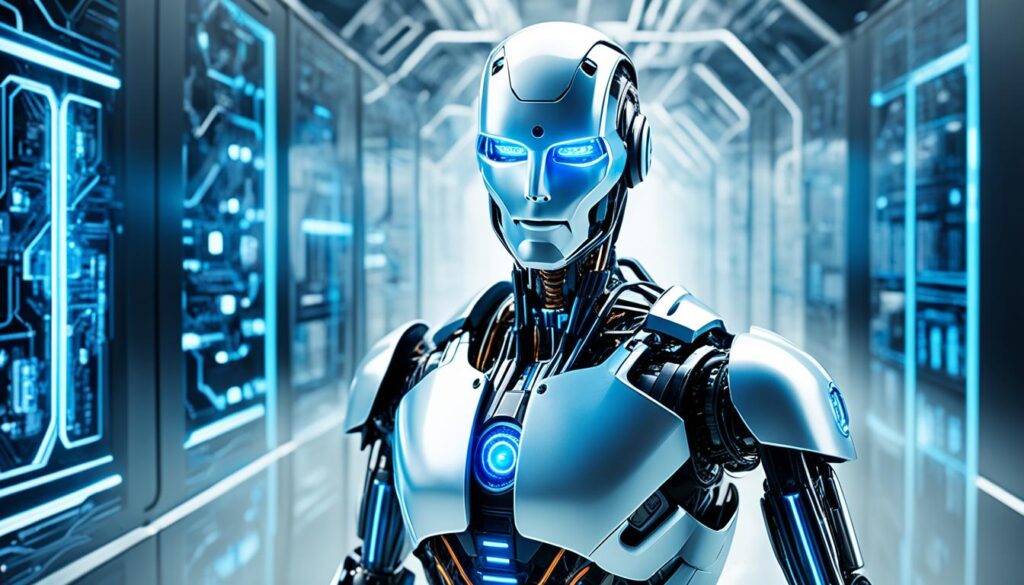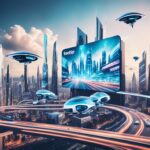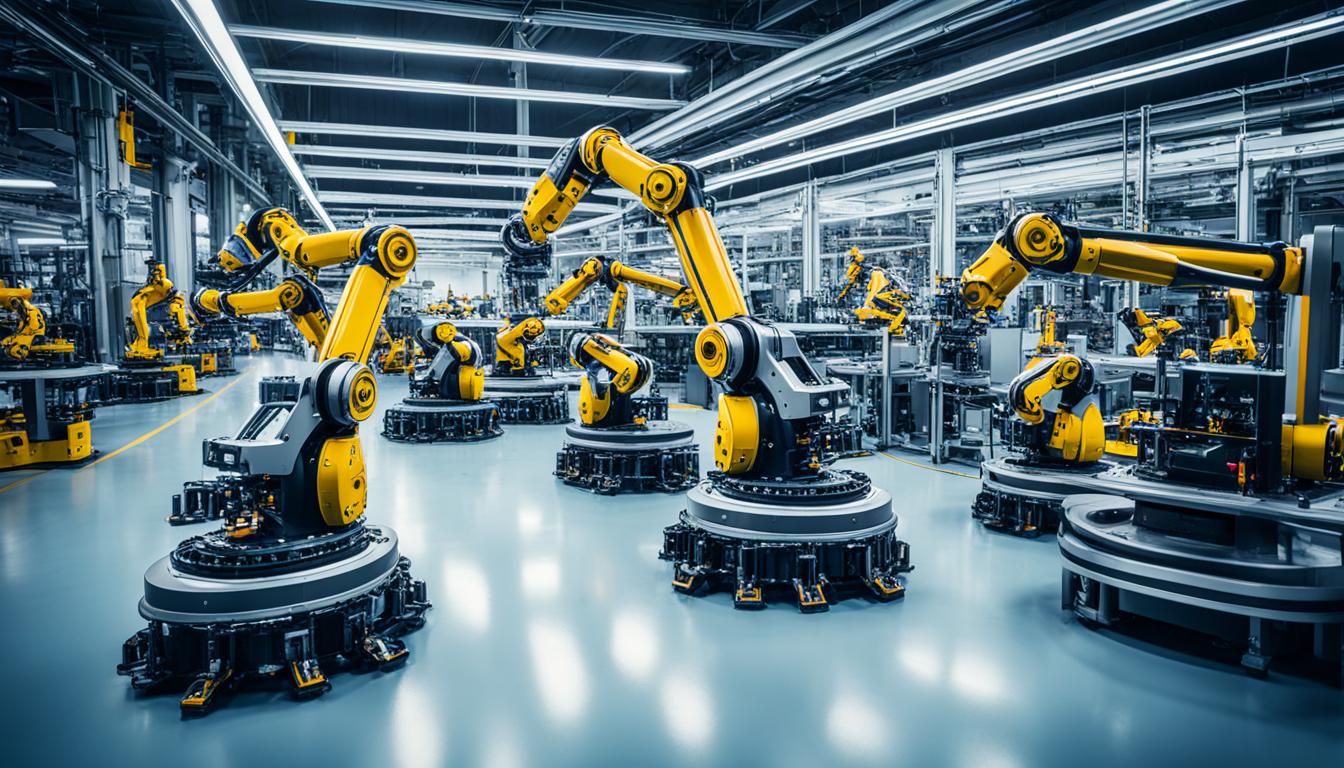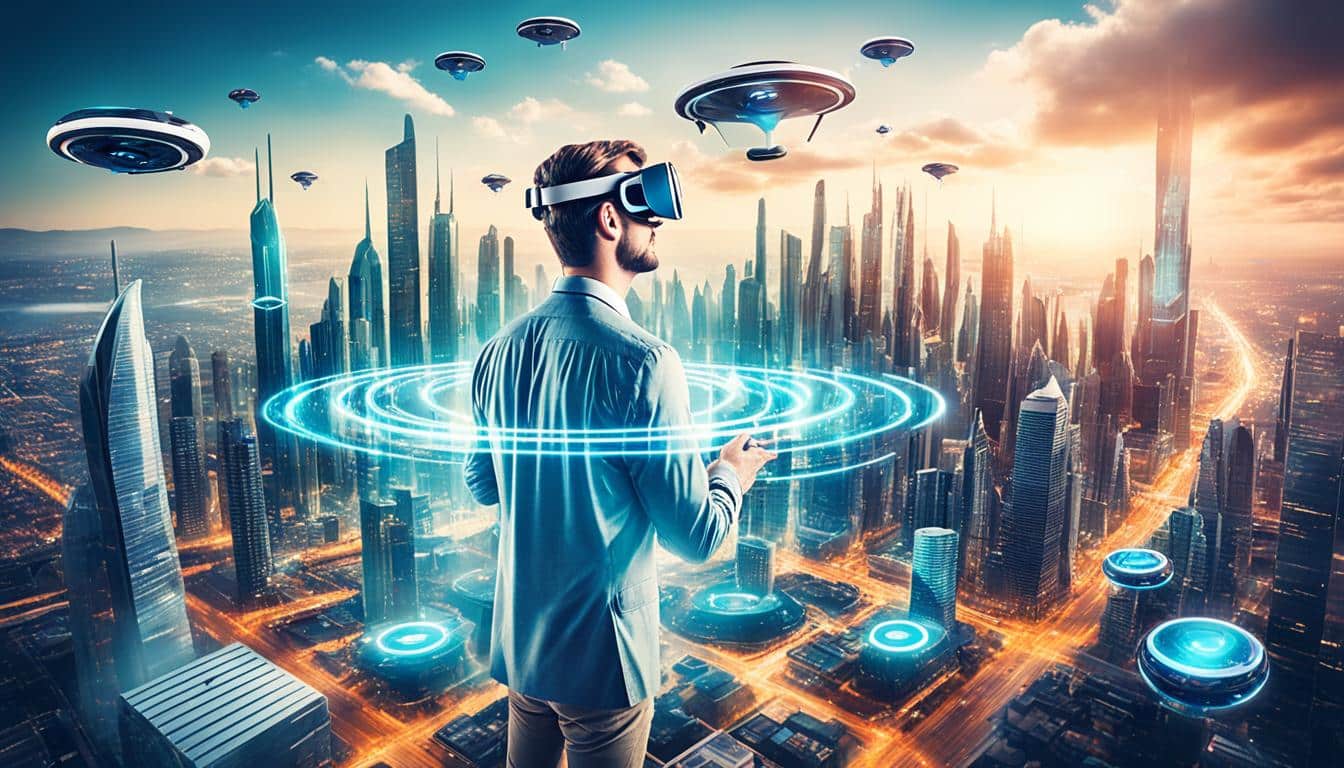Future Innovations : Welcome to a glimpse of the future, where cutting-edge innovation and emerging tech trends are set to transform the world as we know it. In this article, we will explore the exciting possibilities that lie ahead in the realm of future technology. From advancements in artificial intelligence and the power of 5G to the convergence of virtual and physical realities in the Metaverse, we will delve into the thrilling innovations that await us in 2025.
Stay ahead of the curve as we uncover the tech trends that will shape industries, revolutionize sectors, and enhance our everyday lives. The future is brimming with potential, and it’s time to discover the remarkable innovations that are set to define the next era of technology.
Key Takeaways:
- Future technology is poised to revolutionize various industries and enhance our everyday lives.
- Artificial intelligence, 5G, and the Metaverse are among the top tech trends to watch in 2025.
- These innovations will reshape industries, improve efficiency, and offer new experiences and possibilities.
- Stay informed and be prepared to adapt to the rapid advancements and opportunities that lie ahead.
- Embrace the potential of future technology and be at the forefront of the digital transformation.
The Democratization of AI
Artificial Intelligence (AI) has experienced tremendous growth and interest in recent years, with enterprises of all sizes embracing its potential. What was once exclusive to big companies is now accessible to a wider range of organizations, thanks to the democratization of AI through open-source solutions and lower costs. One notable example of this is OpenAI, which has gained popularity and expects significant revenue.
AI adoption is poised to revolutionize various industries, including finance, healthcare, and manufacturing. With the power of AI, organizations can automate processes, make informed decisions, and enhance customer service. The democratization of AI means that these advancements are no longer limited to a select few but can be leveraged by a broader audience.
Open-Source AI Solutions
Open-source AI solutions have played a pivotal role in democratizing AI. These solutions provide access to powerful algorithms and tools that can be freely utilized and modified. By removing barriers to entry, open-source AI solutions have empowered individuals and organizations to explore and innovate in the field of AI.
One such open-source AI solution is TensorFlow, developed by Google. It has become a popular choice among developers and researchers for creating machine learning models. TensorFlow’s versatility and community support have contributed to its widespread adoption.
AI technology is no longer limited to big enterprises, thanks to open-source solutions and lower costs.
The Potential Impact of Democratized AI
The democratization of AI has the potential to revolutionize industries by unlocking new opportunities for automation, decision-making, and customer service. Here are some examples of how AI is transforming different sectors:
- In finance, AI-powered algorithms can analyze vast amounts of data to identify patterns and make data-driven investment decisions.
- In healthcare, AI can assist in medical diagnoses, drug discovery, and personalized treatment plans, improving patient outcomes.
- In manufacturing, AI-enabled robotics can optimize production processes, increase efficiency, and enhance quality control.
The democratization of AI means that organizations of all sizes can harness its potential and gain a competitive edge in their respective industries.
The Future of AI Adoption
As AI continues to evolve and become more accessible, we can expect its adoption to accelerate further. With advancements in machine learning, natural language processing, and deep learning, AI capabilities will become even more sophisticated.
Additionally, the democratization of AI will lead to increased collaboration and knowledge-sharing among AI practitioners and researchers. This collective effort will drive innovation and unlock new possibilities for AI applications in diverse domains.
In summary, the democratization of AI through open-source solutions and lower costs has paved the way for widespread adoption and exploration of this transformative technology. With AI becoming more accessible and its potential impact on industries, organizations must embrace this democratization to stay competitive and leverage the power of AI for their growth and success.
| Benefits of the Democratization of AI | Challenges of the Democratization of AI |
|---|---|
|
|
Innovation and Investment in Cleantech Grows

The investment in clean energy and cleantech is experiencing unprecedented growth, as organizations worldwide recognize the urgent need to transition to low-carbon energy sources. With a record-breaking amount of funding pouring into clean energy projects, the future of sustainable technology looks promising. Two significant areas of focus within the cleantech sector are green hydrogen and carbon capture technology.
The Rise of Green Hydrogen
Green hydrogen, produced through the electrolysis of water using renewable energy sources, is emerging as a key player in the transition to clean energy. This sustainable source of energy has the potential to revolutionize various industries, including transportation, heating, and industrial processes. The market for green hydrogen is projected to experience significant growth in the coming years, with increased investments in hydrogen-focused projects.
“Green hydrogen represents a game-changer in our quest for clean energy. It has the potential to decarbonize sectors traditionally reliant on fossil fuels while offering a reliable and sustainable energy solution.” – Dr. Sarah Johnson, Energy Consultant
To capitalize on the growing demand for green hydrogen, countries and companies are investing in infrastructure and research and development. Additionally, partnerships between renewable energy companies and hydrogen producers are forming, strengthening the clean energy ecosystem.
The Potential of Carbon Capture Technology
As the urgency to combat climate change intensifies, carbon capture technology is gaining traction as a vital solution. This innovative technology captures carbon dioxide emissions from industrial processes and stores them underground, preventing them from entering the atmosphere. By reducing and reversing emissions, carbon capture technology contributes to the overall goal of achieving carbon neutrality.
Funding for carbon capture technology has increased significantly, with governments and businesses recognizing its potential to mitigate the effects of climate change. Research and development efforts are focused on enhancing the efficiency and scalability of carbon capture systems, making them more accessible and cost-effective.
The Importance of Clean Energy Investment
Clean energy investment plays a fundamental role in driving the development and implementation of sustainable technologies. It enables the scaling up of clean energy projects, encourages innovation, and facilitates the adoption of green solutions. As the financial support for clean energy continues to grow, the transition to a low-carbon future becomes more achievable.
Businesses and investors are increasingly recognizing the economic and environmental benefits of clean energy investment. The clean energy sector offers not only a pathway to a more sustainable future but also lucrative opportunities for long-term growth.
| Benefits of Clean Energy Investment | Effect on Environment | Economic Implications |
|---|---|---|
| Reduces greenhouse gas emissions | Creates jobs in the clean energy sector | Enhances energy security |
| Decreases dependence on fossil fuels | Improves air quality | Drives technological innovation |
| Promotes sustainable development | Reduces the risk of climate change impacts | Attracts investment and boosts economies |
Investing in clean energy not only yields positive environmental outcomes but also represents a strategic financial choice with long-term benefits for both society and the economy.
The growth in clean energy investment, coupled with advancements in green hydrogen and carbon capture technology, marks an important shift towards a sustainable and decarbonized future. By harnessing the power of renewable energy and innovative solutions, we can combat climate change, reduce emissions, and create a cleaner, more resilient planet for generations to come.
Tech for Early Disease Detection Advances

Early disease detection is a critical area of technological advancement that holds great promise for improving survival rates. Researchers and startups are investing resources into cutting-edge technologies that can detect diseases at an early stage, enabling timely intervention and treatment. Two key areas of innovation in early disease detection are the use of AI in healthcare and the application of nanotechnology.
The Role of AI in Early Disease Detection
AI in healthcare has the potential to revolutionize the way diseases are detected and diagnosed. Machine learning algorithms can analyze vast amounts of medical data, identifying patterns and indicators that humans may miss. This enables healthcare professionals to make more accurate and timely diagnoses, increasing the chances of successful treatment.
One example of AI-driven early disease detection is the assessment of lung cancer risk. By analyzing patterns in medical scans, AI models can predict the likelihood of developing lung cancer. This information can be used to identify individuals who are at a higher risk and provide them with proactive screening and preventive measures.
Nanotechnology in Early Disease Detection
Nanotechnology is another field that shows great promise in early disease detection. By developing innovative diagnostic tools at the nanoscale, researchers are paving the way for faster, more accurate, and less invasive detection methods.
One example is the development of lab-on-a-chip tests that can detect specific bio-markers for diseases such as pancreatic cancer. These miniature diagnostic devices can analyze a small sample of blood or tissue, providing rapid results and early detection of diseases that can be challenging to diagnose in their early stages.
Smartphone-Based Diagnostics
Nanotechnology is also being leveraged to create smartphone-based diagnostics that can detect a wide range of diseases. These portable devices use nanosensors to capture and analyze biological samples, delivering real-time results to users. By utilizing the widespread availability of smartphones, these diagnostic tools can reach remote areas and underserved populations, improving access to early disease detection.
The Rise of Artificial Intelligence: Beyond Automation to Cognitive Evolution

Artificial Intelligence (AI) is taking a significant leap forward, moving beyond mere automation and entering the realm of cognitive evolution. This transformative shift is driven by the convergence of machine learning, neural networks, and natural language processing, creating intelligent systems capable of understanding, learning, and adapting.
Cognitive AI goes beyond the traditional boundaries of task performance, becoming thinking partners that can revolutionize various fields and industries. With their ability to comprehend complex data, analyze patterns, and make informed decisions, cognitive AI systems have the potential to reshape the way we approach customer service, marketing, data analysis, and even complex coding tasks.
The applications of cognitive AI are vast and far-reaching. Let’s explore some of the areas where it is making a significant impact:
1. Customer Service:
Cognitive AI enables natural language processing, allowing chatbots and virtual assistants to understand and respond to customer queries, enhancing the overall customer service experience.
2. Marketing:
By analyzing vast amounts of data, cognitive AI can create personalized marketing campaigns, target specific customer segments, and optimize marketing strategies for better results.
3. Data Analysis:
Cognitive AI systems excel at processing and analyzing large volumes of data, uncovering hidden patterns and insights that can drive better decision-making and business outcomes.
4. Complex Coding:
With their ability to analyze code and learn from existing databases, cognitive AI systems can assist developers in writing high-quality code, automating repetitive tasks, and improving overall software development efficiency.
“Cognitive AI systems have the potential to revolutionize the way we work, making tasks more efficient, insights more meaningful, and decisions more intelligent.” – Industry Expert
Cognitive AI is poised to take technology to new horizons, empowering industries and professionals to achieve greater levels of productivity, innovation, and success. As AI continues its cognitive evolution, the possibilities are endless, and the impact on society and the economy is bound to be profound.
| Benefits of Cognitive AI | Examples |
|---|---|
| Enhanced decision-making | Cognitive AI systems analyzing financial data to make investment recommendations |
| Increased efficiency | Chatbots providing instant support and resolving customer queries |
| Improved personalization | Cognitive AI systems offering personalized shopping recommendations based on user behavior |
| Advanced data analysis | Cognitive AI systems identifying and categorizing patterns in large datasets |
5G Unleashed: The Backbone of Hyperconnectivity

The fifth-generation technology standard for cellular networks, 5G, is not just an upgrade but a game-changer. Its lightning-fast speed and low latency will enable hyperconnectivity across various sectors.
With 5G technology, the possibilities for seamless connectivity and real-time data transfer are endless. Smart cities, in particular, will benefit greatly from 5G’s capabilities, as it enables efficient management of various systems and services. From transportation and energy to public safety and healthcare, 5G will revolutionize how cities operate and enhance the quality of life for residents.
Augmented reality (AR) is another area that will be significantly transformed by the power of 5G. The combination of 5G’s high bandwidth and low latency will enable immersive AR experiences with real-time data streaming and interaction. From gaming and entertainment to industrial design and healthcare, AR applications will become more sophisticated and pervasive, revolutionizing how we perceive and interact with the world around us.
5G will serve as the backbone of hyperconnectivity, enabling a multitude of devices and technologies to seamlessly communicate and collaborate. The era of the Internet of Things (IoT) will be fully realized, with billions of interconnected devices exchanging data in real-time. This level of hyperconnectivity will unlock new possibilities in areas such as autonomous vehicles, remote monitoring, and precision agriculture.
Let’s take a closer look at some key areas that will be transformed by the power of 5G:
1. Smart Cities
Smart cities leverage advanced technologies, including 5G, to optimize urban infrastructure and enhance the quality of life for residents. With 5G-enabled connectivity, cities can seamlessly integrate various systems such as traffic management, energy distribution, and waste management to operate efficiently and sustainably. Real-time data analysis and communication will enable cities to respond promptly to changing conditions and deliver better services to their inhabitants.
2. Augmented Reality
Augmented reality (AR) overlays digital information onto the physical world, enhancing our perception and interaction with the environment. With the power of 5G, AR experiences will become more immersive, responsive, and interactive. For example, doctors can perform remote surgeries with real-time guidance from specialists, architects can visualize designs on-site, and consumers can experience virtual shopping environments. 5G will enable seamless data transfer and reduce latency, ensuring a smooth and uninterrupted AR experience.
3. Internet of Things (IoT)
The Internet of Things (IoT) involves interconnecting physical devices and objects to exchange data and perform tasks autonomously. 5G’s low latency and high bandwidth will empower the IoT, enabling billions of devices to communicate and collaborate in real-time. This will unlock a range of applications, including smart homes, connected vehicles, industrial automation, and precision agriculture. With 5G, the IoT will reach its full potential, revolutionizing how we live, work, and interact with technology.
| Benefits of 5G in Smart Cities and AR | Benefits of 5G in IoT |
|---|---|
| Enhanced urban infrastructure management | Seamless connectivity for billions of devices |
| Real-time data analysis and response | Low latency for real-time decision-making |
| Improved services for residents | Efficient automation and optimization |
| Interactive and immersive AR experiences | Advanced applications across industries |
| Efficient resource utilization | Enhanced productivity and cost savings |
With 5G technology at the helm, hyperconnectivity is set to revolutionize the way we interact with technology and pave the way for a smarter, more connected world. From smart cities and augmented reality to the Internet of Things, 5G’s impact will be felt across multiple sectors, promising advanced applications and services that will transform our lives.
The Metaverse: Where Virtual and Physical Realities Converge

The Metaverse is a space where virtual and physical realities merge, creating an immersive digital environment. Extended reality (XR), virtual reality (VR), and augmented reality (AR) technologies blend together to provide new ways of experiencing the digital realm. From virtual workspaces to social interactions, the Metaverse offers a parallel universe that blurs the boundaries between the physical and digital worlds. As technology continues to evolve, the Metaverse will shape how we connect, collaborate, and explore in the digital age.
Virtual reality (VR) transports users to entirely simulated environments, providing a captivating and interactive experience. With the help of specialized headsets, users can immerse themselves in virtual worlds and interact with digital objects and characters. Whether it’s exploring ancient ruins or playing realistic video games, VR offers endless possibilities for entertainment and education.
Augmented reality (AR) enhances our physical environment by overlaying digital content onto real-world objects. Through the use of smartphones, tablets, or wearable devices, AR allows us to see computer-generated graphics, information, and animations integrated seamlessly into our surroundings. From interactive training simulations to visualizing architectural designs, AR is transforming various industries and enabling new forms of engagement.
Extended reality (XR) is an umbrella term that encompasses virtual reality, augmented reality, and mixed reality (MR). MR combines elements of both VR and AR, blending digital content with the real world to create a hybrid environment. This convergence allows users to interact with both virtual and physical objects simultaneously, offering an even more immersive and interactive experience.
The Metaverse represents the next frontier in digital technology, where virtual and physical realities converge. It offers a new dimension of human interaction, collaboration, and exploration, transcending the limitations of traditional mediums. As more advancements are made in extended reality, virtual reality, and augmented reality, the possibilities for the Metaverse are endless.
The Impact of the Metaverse
The Metaverse has the potential to redefine how we live, work, and play. Here are some key areas where the Metaverse is poised to make a significant impact:
- Social Interaction: The Metaverse enables people from around the world to connect, collaborate, and socialize in immersive digital environments. Virtual social platforms, virtual events, and virtual meetups are just a few examples of how the Metaverse is transforming social interactions.
- Virtual Workspaces: With the rise of remote work and digital collaboration tools, the Metaverse offers a new paradigm for virtual workspaces. From virtual offices to virtual team building activities, the Metaverse can enhance productivity, foster creativity, and facilitate seamless remote collaboration.
- Entertainment and Gaming: The gaming industry has already embraced the concept of the Metaverse, offering immersive multiplayer experiences and virtual worlds. Beyond gaming, the Metaverse has the potential to revolutionize entertainment, enabling interactive storytelling, virtual concerts, and immersive theater experiences.
The Future of the Metaverse
As technology continues to advance and become more accessible, the Metaverse will continue to evolve and expand its possibilities. With the integration of artificial intelligence, haptic feedback systems, and advancements in hardware, the Metaverse could become even more immersive and indistinguishable from the physical world.
However, challenges such as privacy, security, and inclusivity must also be addressed as the Metaverse becomes more prominent. Striking a balance between user experience and ethical considerations will be crucial in shaping the future of the Metaverse.
Ultimately, the Metaverse holds the potential to transform how we interact with technology, each other, and the world around us. As it continues to develop and mature, the boundaries between virtual and physical realities will blur, opening up a new frontier of possibilities for human expression, creativity, and exploration.
Blockchain Beyond Cryptocurrency: Transforming Industries
While the concept of blockchain technology is often associated with cryptocurrency, its potential surpasses the realm of digital currencies. Various industries, including supply chain management and healthcare, are leveraging blockchain to revolutionize their operations.
Blockchain technology offers benefits such as enhanced transparency, improved efficiency, and increased security. Its decentralized nature ensures that information is stored and shared in a secure and tamper-proof manner. Additionally, smart contracts enable automated and trustworthy execution of agreements, streamlining business processes.
Let’s explore how blockchain is transforming industries beyond finance:
Supply Chain Management:
Blockchain technology is revolutionizing supply chain management by creating end-to-end visibility and traceability. With blockchain, each step of the supply chain can be recorded, from the origin of raw materials to the final distribution of products. This transparency helps identify inefficiencies, eliminate counterfeits, and ensure compliance with regulations.
Healthcare:
In the healthcare industry, blockchain technology offers numerous advantages. Patient records can be securely stored on the blockchain, ensuring accurate and immutable medical histories. This enhances interoperability among healthcare providers and improves patient care. Additionally, blockchain enables secure sharing of sensitive data while maintaining privacy, facilitating research collaborations and accelerating medical advancements.
“Blockchain technology allows us to rethink the way we manage and share information, bringing trust and efficiency to industries beyond finance.” – John Smith, CEO of Blockchain Solutions Inc.
Blockchain technology’s transformative potential in various sectors is undeniable. By fostering transparency, efficiency, and security, blockchain is reshaping industries beyond its cryptocurrency roots. Embracing this technology paves the way for increased trust, collaboration, and innovation.
The Importance of Data in the Future of Technology

Data plays a crucial role in shaping the future of technology. As organizations strive to stay competitive in the digital landscape of 2025, they are increasingly harnessing the power of data to gain valuable insights, improve decision-making, and drive business objectives.
Advanced analytics, AI, and machine learning have become essential tools for processing and analyzing the vast volumes of data generated in today’s digital world. These technologies enable organizations to uncover patterns, trends, and correlations that would be otherwise difficult to detect. By utilizing data effectively, organizations can make informed decisions, optimize processes, and identify new opportunities for growth.
The Power of Advanced Analytics
Advanced analytics techniques, such as predictive modeling, data mining, and data visualization, allow organizations to extract valuable insights from complex datasets. By leveraging these techniques, businesses can uncover hidden patterns, identify outliers, and make more accurate predictions.
“Data is the new oil, and advanced analytics is the refinery that transforms it into actionable insights.”
With advanced analytics, organizations can gain a deeper understanding of their customers, improve product development, optimize supply chains, and enhance overall operational efficiency. By leveraging advanced analytics, businesses can stay ahead of the competition and drive innovation in their respective industries.
The Role of AI and Machine Learning
AI and machine learning techniques are revolutionizing data analysis by automating the process of extracting insights from large and complex datasets. These technologies enable organizations to uncover patterns, make predictions, and automate decision-making processes.
By utilizing AI and machine learning algorithms, businesses can analyze vast amounts of data with speed and accuracy, identifying valuable insights that can drive business strategies. AI-powered systems can also adapt and learn from new data, continuously improving their capabilities over time.
Machine learning algorithms, such as neural networks and deep learning, can uncover complex relationships and make highly accurate predictions. These algorithms can be used in various applications, including recommendation systems, fraud detection, natural language processing, and image recognition.
The increasing utilization of AI and machine learning technologies empowers organizations to transform data into actionable intelligence, enabling them to make data-driven decisions and gain a competitive edge in today’s data-driven world.
The Future of Data in Technology
In the future, data will continue to play a pivotal role in technology advancements. As the volume, variety, and velocity of data increase, organizations must build robust data strategies that encompass data collection, storage, analysis, and utilization.
By effectively utilizing data, businesses can unlock new opportunities, improve customer experiences, drive innovation, and achieve sustainable growth. As technology evolves, organizations that harness the power of data and leverage advanced analytics, AI, and machine learning will be at the forefront of innovation and digital transformation.
In conclusion, data utilization, advanced analytics, AI, and machine learning are essential components of the future of technology. As organizations embrace these technologies and harness the power of data, they can gain valuable insights, make informed decisions, and unlock new possibilities for growth and innovation.
The Role of CIOs in the Technology Transformation

Chief Information Officers (CIOs) play a crucial role in leading the technology transformation within organizations. As technology continues to evolve at a rapid pace, CIOs are responsible for developing and implementing a comprehensive technology strategy that aligns with the business objectives of their organizations.
In order to deliver exceptional experiences and services, CIOs must possess not only technical expertise but also strong business acumen. They are tasked with synthesizing various technologies and identifying how these technologies can be leveraged to drive innovation and improve operational efficiency. CIOs must have a deep understanding of the organization’s goals and objectives, and they must be able to translate these into a clear technology roadmap.
Collaboration and cross-functional teams play a critical role in the technology transformation process. CIOs must work closely with other departments and stakeholders to ensure that technology initiatives are aligned with the overall business strategy. By fostering collaboration, CIOs can create a culture of innovation and empower their teams to drive meaningful change.
Anticipating future technological needs is another important aspect of the CIO’s role. Technology is constantly evolving, and CIOs must stay abreast of emerging trends and advancements in order to develop strategies that will meet the organization’s future needs. By proactively identifying and evaluating new technologies, CIOs can position their organizations for success in the digital age.
“The role of the CIO is no longer just about managing IT capabilities. It’s about driving the technology strategy and transformation that will enable the organization to thrive in a rapidly changing digital landscape.”
Effective CIOs understand the importance of building and developing strong IT capabilities within their organizations. This includes attracting and retaining top talent, fostering a culture of continuous learning and improvement, and investing in the right infrastructure and tools. By nurturing IT capabilities, CIOs can ensure that their organizations have the resources and expertise needed to leverage technology for competitive advantage.
Key Responsibilities of CIOs in Technology Transformation
| Responsibility | Description |
|---|---|
| Developing Technology Strategy | Creating a comprehensive technology roadmap aligned with the organization’s goals and objectives. |
| Synthesizing Technologies | Identifying and integrating various technologies to drive innovation and operational excellence. |
| Collaboration and Cross-Functional Teams | Working closely with other departments and stakeholders to align technology initiatives with the overall business strategy. |
| Anticipating Future Technological Needs | Staying abreast of emerging trends and advancements to develop strategies that will meet future needs. |
| Building IT Capabilities | Attracting and retaining top talent, fostering a culture of learning and improvement, and investing in infrastructure and tools. |
With the rapid pace of technological change, the role of the CIO has never been more critical. By embracing their responsibilities as leaders of technology transformation, CIOs can drive innovation, enhance operational efficiency, and position their organizations for success in the digital age.
The Skills and Capabilities of the IT Workforce
As technology continues to advance at a rapid pace, the IT workforce must adapt and acquire new skills to stay relevant in the digital age. Today’s IT professionals need more than just technical expertise; they need a diverse set of skills that can drive innovation, solve complex problems, and contribute to the overall success of their organizations.
Critical Thinking and Problem-Solving
One of the most valuable skills for IT professionals is critical thinking. They need to be able to analyze complex situations, evaluate different options, and make informed decisions that align with business objectives. Problem-solving is another crucial skill, as IT professionals often encounter challenges and must find creative solutions to overcome them.
Emotional Intelligence
While technical skills are essential, emotional intelligence is becoming increasingly important in the IT field. IT professionals need to have strong interpersonal skills, empathy, and the ability to communicate effectively with colleagues and clients. This not only fosters collaboration but also helps build strong relationships that are vital for success in any organization.
Innovation and Ideation
Innovation is the driving force behind technological advancements, and IT professionals play a key role in identifying opportunities for innovation within their organizations. They need to be curious, open to new ideas, and able to think outside the box. By embracing innovation and ideation, IT professionals can leverage technology to drive growth, improve processes, and differentiate their organizations from competitors.
Collaboration and Business Acumen
Collaboration is crucial for IT professionals as they work closely with cross-functional teams and stakeholders across the organization. They need to be able to effectively communicate with individuals from different backgrounds and disciplines, fostering effective teamwork and alignment towards shared goals. Additionally, IT professionals need to have a solid understanding of business processes and objectives, enabling them to align technology initiatives with the strategic priorities of their organizations.
Agile Methodologies and Automation
Agile methodologies have gained popularity in the IT industry for their ability to enhance flexibility, collaboration, and efficiency. IT professionals should be well-versed in agile principles and practices, allowing them to adapt quickly to changing requirements and deliver value to their organizations. Automation is another essential skill as organizations increasingly seek ways to streamline processes and improve productivity. IT professionals need to have a strong understanding of automation tools and techniques to drive digital transformation and optimize workflows.
In conclusion, the IT workforce of 2025 must possess a diverse set of skills and capabilities beyond technical expertise. Critical thinking, problem-solving, emotional intelligence, innovation, collaboration, business acumen, agile methodologies, and automation are all essential for success in the rapidly evolving technology landscape. By continuously adapting and acquiring these skills, IT professionals can thrive and drive the future of technology in their organizations.
Conclusion
As we look towards the future of technology, the possibilities for advancement and innovation are boundless. The emergence of AI, 5G, the Metaverse, and blockchain is set to reshape industries, revolutionize our daily lives, and bring about a new era of digital transformation. These tech trends hold immense potential in enhancing productivity, driving efficiencies, and fueling growth across sectors.
Throughout this article, we have explored how CIOs and IT professionals are integral to navigating this digital landscape. Their role includes continuously learning, adapting, and innovating to leverage the full potential of future technology. With their expertise in harnessing emerging tech trends, organizations can stay ahead of the curve and capitalize on the opportunities that digital transformation presents.
As we move forward, it is essential to approach this future of technology with the right mindset and strategic approach. The ongoing collaboration between business leaders and technology experts will be crucial in charting a path towards success. By embracing these tech trends, we can shape a brighter future where innovation and connectivity reign, and digital transformation becomes the driving force behind progress.
Also Refer : The Power Of American Virtual Cloud Technologies Unleashed
FAQs
Q: What is the three horizons framework?
A: The three horizons framework is a strategic model that helps organizations think about the future in the present. It divides innovation projects into three horizons: the first horizon focuses on ‘business as usual,’ the second horizon deals with longer-term innovation, and the third horizon addresses transformative change and emerging future opportunities.
Q: How does the three horizons framework help organizations?
A: The framework provides a way for organizations to address the challenges of today while also shaping the future. It helps in developing a vision for future growth and transformation, and enables companies to balance short-term goals with long-term innovation strategies.
Q: What are the key components of the three horizons model?
A: The key components of the three horizons model include horizon 1 (h1) for existing systems and ‘business as usual,’ horizon 2 (h2) for longer-term innovation and disruptive innovations, and horizon 3 (h3) for transformative change and future vision.
Q: What is the significance of horizon 1, horizon 2, and horizon 3 in the framework?
A: Horizon 1 represents the current core business operations, horizon 2 focuses on innovation projects that address challenges to the first horizon, and horizon 3 nurtures seeds for future growth, transformative change, and horizon 3 innovations.
Q: How does the three horizons thinking help in shaping the future?
A: It helps organizations by providing a structured approach to simultaneously managing current operations, innovation projects, and long-term transformative change. This allows companies to envision and create a future that aligns with their long-term strategies.
Q: What are examples of disruptive innovation in the context of the three horizons framework?
A: Disruptive innovations, often found in horizon 2, are completely new and challenge the status quo. Examples include technologies or business models that reshape industries, creating significant changes in how things are done.
Q: How can the three horizons framework be used as a tool for innovation strategy?
A: The framework helps in developing an innovation strategy that balances incremental improvements with visionary and long-term transformations. It enables organizations to address the challenges of today while also preparing for the future.
Q: What organizations or institutions are associated with the three horizons framework?
A: The three horizons framework is associated with organizations such as McKinsey, International Futures Forum, Board of Innovation, and others who use it as a strategic tool for thinking about the future and driving transformative change.
Q: How does the three horizons framework address the need for cultivating future consciousness?
A: The framework helps in addressing the need for cultivating future consciousness by encouraging organizations to think about the future in the present. It provides a structured approach for considering the longer-term implications of today’s actions and decisions.
Q: In what ways does the three horizons framework contribute to the innovation strategy of an organization?
A: The framework contributes to the innovation strategy by providing a systematic way to balance short-term and long-term innovation efforts. It helps in identifying and pursuing transformative changes, shaping innovative visions, and addressing the challenges of the present and the future.













